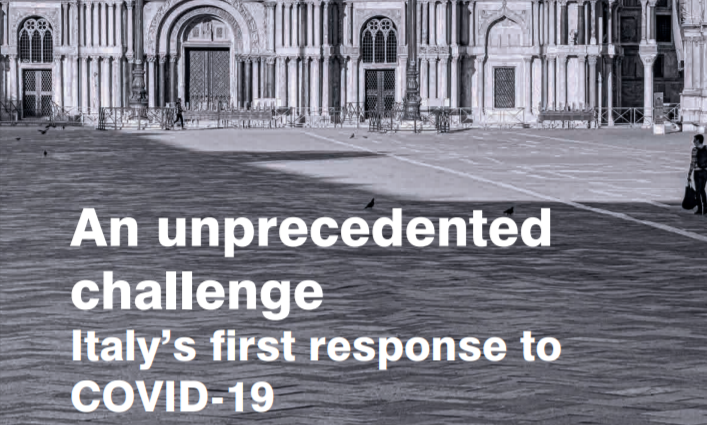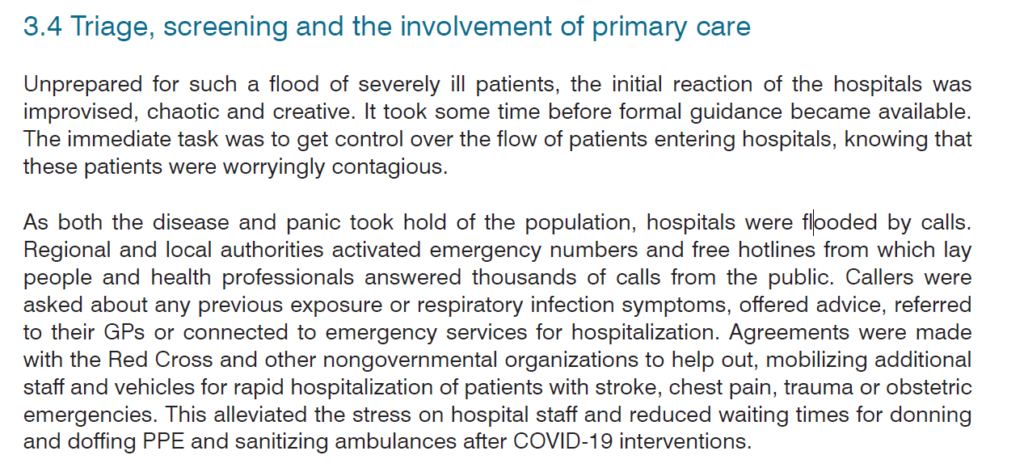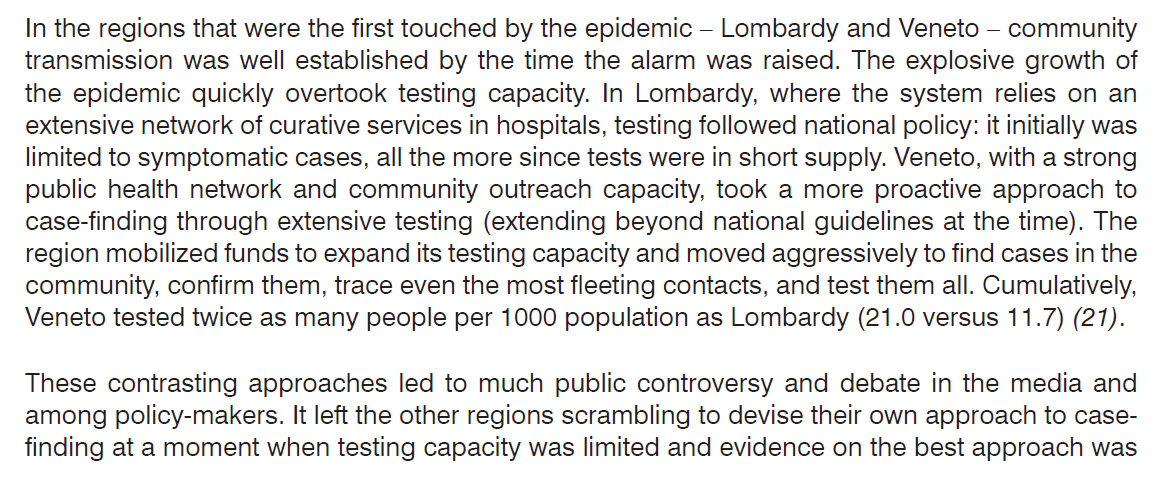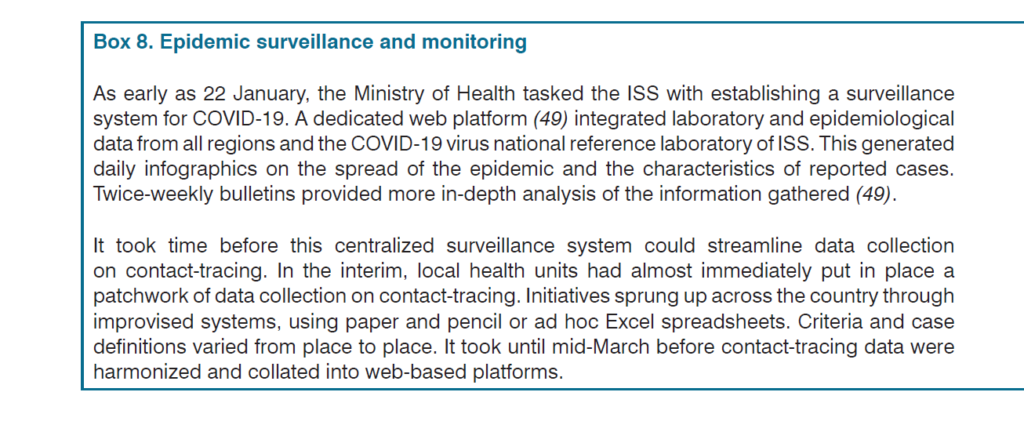Covid, what the WHO report ambushed by WHO says about Italy

All the criticisms on the Italian management of the Covid pandemic contained in the report of 10 WHO researchers drafted by the WHO itself, according to the Rai3 report. The findings on the Ministry of Health and Iss. Appreciation for the activity of the Veneto. And the role of Ranieri Guerra, WHO deputy director
Lack of pandemic plan, bad choices, delays. The report "An unprecedented challenge, Italy's first response to Covid" , written by 10 WHO researchers, tells in 100 pages the inadequate response of Italy to the pandemic.
That report, according to the Report broadcast , was inconvenient for the government and Ranieri Guerra, former director of the Ministry of Health ( here the insight ), was published on May 13 by WHO. After a few hours the same Organization withdrew it.
But what is written so inconvenient in the report on Italy.
THE REPORT
The report "An unprecedented challenge, Italy's first response to Covid" was financed with about 100 thousand dollars from a loan from Kuwait and describes how Italy has faced the arrival of the pandemic in the country. Leading the working group that drafted the dossier was Francesco Zambon, Investment for Health and Development (HES) coordinator in Healthy Settings ( who is now afraid of being fired ).
A CAOTIC AND IMPROVISED RESPONSE
In fact, in the report she becomes a merciless photographer of Italy. The response to Covid-19 was wholly inadequate: “Unprepared for such a flood of seriously ill patients, the initial reaction of the hospitals was improvised, chaotic and creative. It took some time for formal guidance to become available, ”the WHO report reads.

NO UPDATED PANDEMIC PLAN
No surprise on the impromptu response. Italy did not have an updated pandemic plan.
“Italy was not entirely unprepared for an epidemic when the first news from China arrived. In 2006, after the first epidemic of severe acute respiratory syndrome (SARS), the Italian Ministry of Health and the regions approved a national plan for the preparation and response to the pandemic flu ”. A plan that was, explain the WHO researchers, only “reconfirmed in 2017 (8-11), with guidelines for regional plans. More recently, the H1N1 / 09 virus in 2009 and the Ebola virus in 2014 have drawn attention to the risk that such phenomena could occur ”.
THE (DIFFERENT) RESPONSE OF LOMBARDY AND VENETO
In the absence of a defined national plan, the regions' response to the pandemic has been different. Lombardy and Veneto, the two regions where the virus first arrived, have chosen different strategies. The first followed, for tests and tracing, the guidelines of the Istituto Superiore di Sanità, swabbing only asymptomatic patients. Veneto has chosen to make carpet pads.
WHAT WHO IS WRITING ABOUT LOMBARDY AND VENETO
“In the regions first hit by the epidemic – Lombardy and Veneto – community broadcasting was consolidated at the time of the alarm. The explosive growth of the epidemic rapidly outstripped testing capacity. In Lombardy, where the system makes use of a dense network of hospital curative services, the tests followed national policy: initially they were limited to symptomatic cases, especially since the tests were scarce. Veneto, with a strong public health network and community outreach capacity, has taken a more proactive approach to case finding through in-depth testing (extending beyond national guidelines at the time). The region mobilized funds to expand its testing capacity and moved aggressively to find cases in the community, confirm them, trace even the most fleeting contacts and test them all. Cumulatively, the Veneto tested double the number of people out of 1000 in Lombardy (21.0 against 11.7) ”.

CHAOS IN OTHER REGIONS
The two different approaches, the researchers continue, "have led to much controversy and public debates in the media and among policy makers". This "left other regions having to work out their own case finding approach at a time when testing capacity was limited and evidence of the best approach was scarce."
THE VENETO MODEL IS PROMOTED
What is the best model for WHO researchers? The Veneto one, which ignored national guidelines. In fact, the report praises what was done to Vo 'Euganeo.
“The first fatal Covod accident in Italy took place in the small town of Vo 'Euganeo (3300 inhabitants) in Veneto. One cluster had developed unnoticed, but the region's rapid response and management has since turned this predicament into a success story of isolation and containment practices, ”WHO researchers write.
“The region immediately decided to isolate the entire municipality and to conduct mass tests on the entire population, including those with no symptoms. By identifying and isolating groups of infected asymptomatic people, Covid-19 was eliminated by Vo in less than 14 days. This innovative and aggressive approach to experimentation and the ambitious use of tampons to contain and stop the chain of transmission has already been the subject of studies by international scientific publications. Experience informed the general approach of the region, whose response was praised for its effectiveness in flattening the disease spread curve ”. In short, a veiled (but not too much) rejection to the Government and the ISS which, unlike the Veneto, followed the indications of the World Health Organization.

DIFFICULT NUMBERS TO INTERPRET
AL rejection that also passes through the interpretation of the data: the different approach to testing policy meant that "the daily bulletins with the numbers of confirmed cases were particularly difficult to interpret, with the indications for the test differing from region to region" , criticizes the WHO.
DELAYS IN THE MONITORING SYSTEM
Not only data that are difficult to interpret, also delays in monitoring. "Already on January 22, the Ministry of Health instructed the ISS to set up a surveillance system for Covid-19. A dedicated web platform integrated epidemiological and laboratory data from all regions and from the national reference laboratory for the Covid-19 virus of the ISS. This generated daily infographics on the spread of the outbreak and the characteristics of reported cases. The biweekly bulletins provided a more in-depth analysis of the information gathered, ”the report reads. “It took some time for this centralized surveillance system to streamline the collection of contact tracing data. Meanwhile, local health units almost immediately put in place a data collection mosaic of contact tracing. The initiatives have sprung up across the country through improvised systems, using paper and pencil or ad hoc Excel sheets. The criteria and case definitions varied from place to place. It took until mid-March for the contact tracing data to be harmonized and collected in platforms ”, denounce researchers from the World Health Organization.

MINISTRY OF HEALTH: NEVER SEEN THIS DOCUMENT
The WHO report never seems to have ended up on the tables of the Ministry of Health. And according to the ministry it would not even be an official WHO document: “as far as we know it is not an official WHO document and has never been sent to the Ministry of Health, which therefore has never evaluated or commented on it. Any information on the matter derives from non-institutional sources ”, they write from the Press Office of the Ministry of Health, in response to the clarifications sought by Report.
HERE IS ITALY'S RESPONSE TO THE PANDEMIC
The ministry also tells Report about the response lines to the pandemic. "As regards the response to Covid-19, Italy's plan is set out in the document" Prevention and response to Covid-19: evolution of the strategy and planning in the transition phase for the autumn-winter period "created by the Ministry of Health , Higher Institute of Health, Higher Council of Health, AIFA, INMI Lazzaro Spallanzani, Civil Protection, Inail, State Regions Conference, AREU 118 Lombardia, Bruno Kessler Foundation (FBK), Extraordinary Commissioner Structure for the implementation and coordination of the necessary measures for the containment and contrast of the epidemiological emergency COVID-19 and others ", explain by the Ministry, specifying that" for "pandemic plan" WHO, ECDC and Italy refer to the Pandemic Influenza Plan which is a public document available on the website of the European Center for Disease Prevention and Control ECDC ( https://www.ecdc.europa.eu/en/seasonalinfluenza/preparedness/influenza-pandemic-preparedness -plans ) and on the website of the Ministry of Health ( http://www.salute.gov.it/imgs/C_17_pubblicazioni_501_allegato.pdf ) ".
PANDEMIC PLAN UNDER UPDATE
And just in recent weeks the Plan is being updated at the Directorate General for Prevention of the Ministry of Health. As the Press Office of the Ministry of Health, we remind you that WHO, ECDC and other international organizations, as they are responsible for, define the recommended containment standards and strategies, in constant discussion with all member countries. Italy, on numerous aspects related to the pandemic challenge, has incorporated the indications of WHO and Ecdc in the measures adopted ”, writes the Ministry.
This is a machine translation from Italian language of a post published on Start Magazine at the URL https://www.startmag.it/sanita/covid-cosa-dice-sullitalia-il-rapporto-oms-imboscato-dalloms/ on Wed, 02 Dec 2020 08:18:57 +0000.
